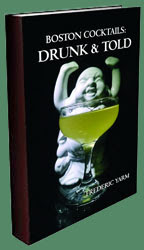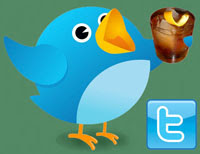 The morning talk I attended on Saturday at Tales of the Cocktail was entitled "The Seven Pillars of Classic Cocktails" and was given by the Bitter Cube's Ira Koplowitz, Marco Zappia, and Nicholas Kosevich as well as author Matthew Rowley who was serving as the group's drink historian. The concept was to teach drink rules when they acted as consultants for setting up new bar programs. The rules serve as a foundation to rest cocktails on so remembering recipes and making drinks up on the fly go smoother, and each of the pillars is a different drink class.
The morning talk I attended on Saturday at Tales of the Cocktail was entitled "The Seven Pillars of Classic Cocktails" and was given by the Bitter Cube's Ira Koplowitz, Marco Zappia, and Nicholas Kosevich as well as author Matthew Rowley who was serving as the group's drink historian. The concept was to teach drink rules when they acted as consultants for setting up new bar programs. The rules serve as a foundation to rest cocktails on so remembering recipes and making drinks up on the fly go smoother, and each of the pillars is a different drink class.The Sour: The Sour starts to appear in print in the middle of the 1800s with an early reference being in an 1856 list of drinks at a Toronto bar, Mart Ackerman's Saloon. The concept stemmed from older drinks, and Wondrich referred to them as one of the "lesser Punches." Sours serve as the dealer's choice on the shaken drink with easy swaps and additions of spice while maintaining a flavor balance that is consistent with the program's sweet/tart balance and spirit forwardness. Consistent shaking needs to be taught such that ice needs to hit both sides of the tin followed by the appropriate straining (see the shaking rules below).
2 oz SpiritNote that citrus here is lemon or lime for orange and grapefruit do not have the same amount of acid content. One can add citric and other acids to orange juice, for example, to make it comparable to lemon or lime as well as last longer. pH meters are great tools to test citrus consistency during a shift, between shifts, and over the course of a season. The syrup should be a 50 Brix one (a/k/a 1:1 syrup), and a refractometer (about $60-70) will confirm the amount of sugar in solution. The above recipe will yield a great Daiquiri, Gimlet, and Whiskey Sour using rum/lime, gin/lime, and Bourbon/lemon, respectively. The speakers commented that the Sour should be called the Balance to better describe the effect.
3/4 oz Citrus
3/4 oz Syrup
In terms of shaking, a bartender just needs to get the job done. There are four styles:
1. Short shake - homogenizes and adds a touch of aeration. Use this when adding dilution later with soda or juice.
2. Standard shake - not just 10-15 seconds but listen to the ice -- a feeling.
3. Long shake - when you want a lot of dilution. Also when using eggs.
4. Mime shake - the dry shake without ice when using egg products (also, reverse mime shake)
The Daisy: The Daisy is a Sour with a liqueur added and sometimes some soda. Daisies first appeared in Jerry Thomas' 1876 edition and many of the early ones had orange liqueur although Harry Johnson preferred Yellow Chartreuse. Since liqueurs vary in Brix and ABV, some syrup may be needed to balance the drink. And very flavorful liqueurs like violette may need less than the standard amount (with the rest being the syrup). When nudging the sweetness with syrup, a quick stir with a spoon is all that is needed since aeration and dilution have already occurred. The Margarita and Sidecar are two great examples that follow this formula.
1 1/2 oz SpiritThe Collins: A Collins is a Sour lightened with non-alcoholic carbonated beverage. Since soda water has an acidic pH of 3-4 from the CO2 dissolved into carbonic acid, a touch more sweetness needs to be added to balance the effect (neutral water is around 7.0 and lemon/lime are around 2.0-2.2). If a sweetened soda is used, the formula will needed to be adjusted in the opposite direction. Utilize a short shake (as described above) to avoid diluting the drink too much. The Tom Collins and Mojito follow this rule.
3/4 oz Citrus
1/2 oz Liqueur
1/4 oz +/- Syrup
2 oz SpiritThe 75: Named after the French 75, this group is a Sour plus sparkling wine that first appears in print in the 1930 Savoy Cocktail Book. Different sparkling wines contain different amounts of sweetness, but much of the nuance is lost when citrus is added. Higher quality sparkling wine does not make better drinks; highly carbonated is optimal, and nearly flavorless is preferable so it will not take over the drink. Like the Collins, utilize a short shake and add the sparkling wine to the tin.
1 oz Syrup
3/4 oz Citrus
2 oz Soda Water
1 oz SpiritRules on egg whites: 1/4 oz more syrup is needed in recipes containing egg white; egg whites dry out the tongue and this needs to be compensated for. The mime shake (dry shake) needs to be used, followed by a long shake with ice. Be confident when using eggs to reassure your guests. Air trapped in egg white drinks does not taste like bubbles but as a creaminess since the bubbles are too small.
1/2 oz Citrus
1/2 oz Syrup
3 oz Sparkling Wine
2 oz SpiritThe Old Fashioned: The original cocktail as defined in 1806 as spirits, sugar, water, bitters. The Old Fashioned is simple but very easily altered into riffs by changing spirit, sweetener, and bitters.
1 oz Syrup
3/4 oz Citrus
1 Egg White
2 oz SpiritThe Two-One-Two: The 212 is the area code for Manhattan, and that is the drink it is based on. The Manhattan first appears in print in the 1870s. The same ratio will make a Manhattan or a Martini with London Dry Gin (with more modern gins that are lighter and more floral, increase the gin by a 1/4 oz and drop the vermouth by a 1/4 oz).
1/4 oz Syrup
2 dash Bitters
2 oz SpiritThe Stepladder: Based off the Negroni which was created around 1920. While the classic is equal parts, switching the ratio adapts the balance for the modern palate.
1 oz Vermouth
2 dash Bitters
1 1/2 oz Spirit
1 oz Vermouth
1/2 oz Bitter Liqueur
 The 2017 collection of 855 drink recipes, bartender tributes, and essays on hospitality from CocktailVirgin's Frederic Yarm. Available at
The 2017 collection of 855 drink recipes, bartender tributes, and essays on hospitality from CocktailVirgin's Frederic Yarm. Available at  The 2012 collection of 505 drink recipes, techniques, and Boston bar recommendations from Frederic Yarm. Available at
The 2012 collection of 505 drink recipes, techniques, and Boston bar recommendations from Frederic Yarm. Available at 




1 comment:
Great article. Short and to the point. Thanks.
Post a Comment